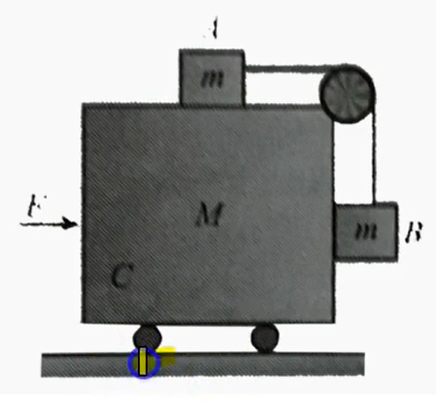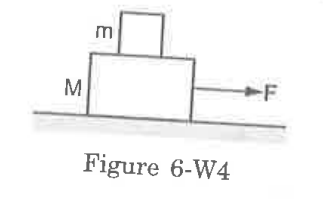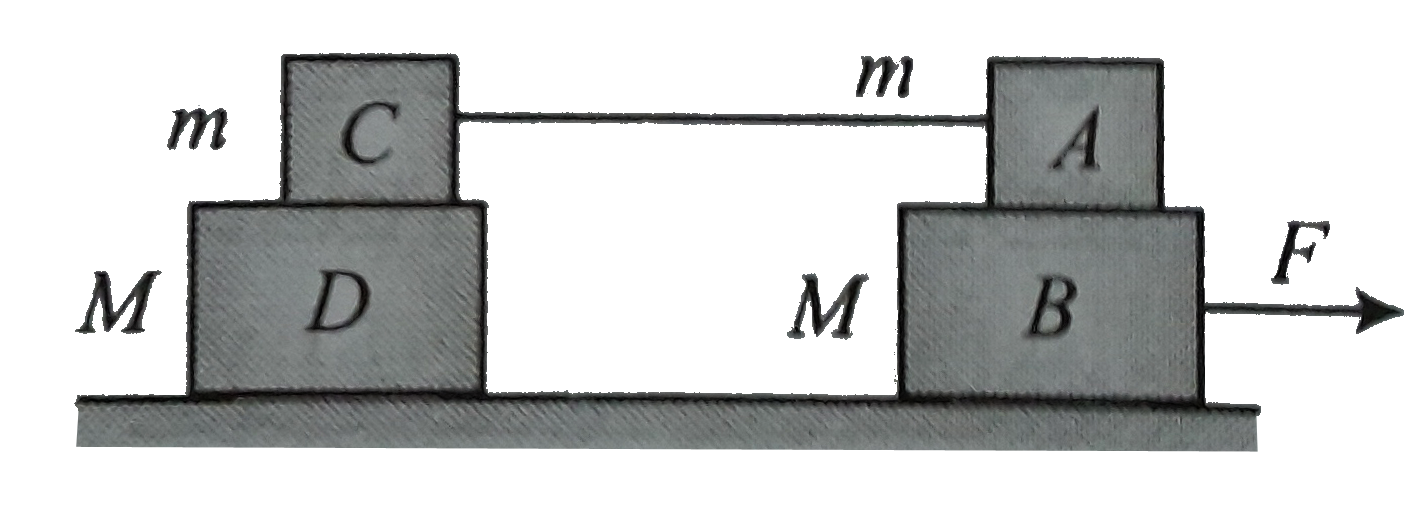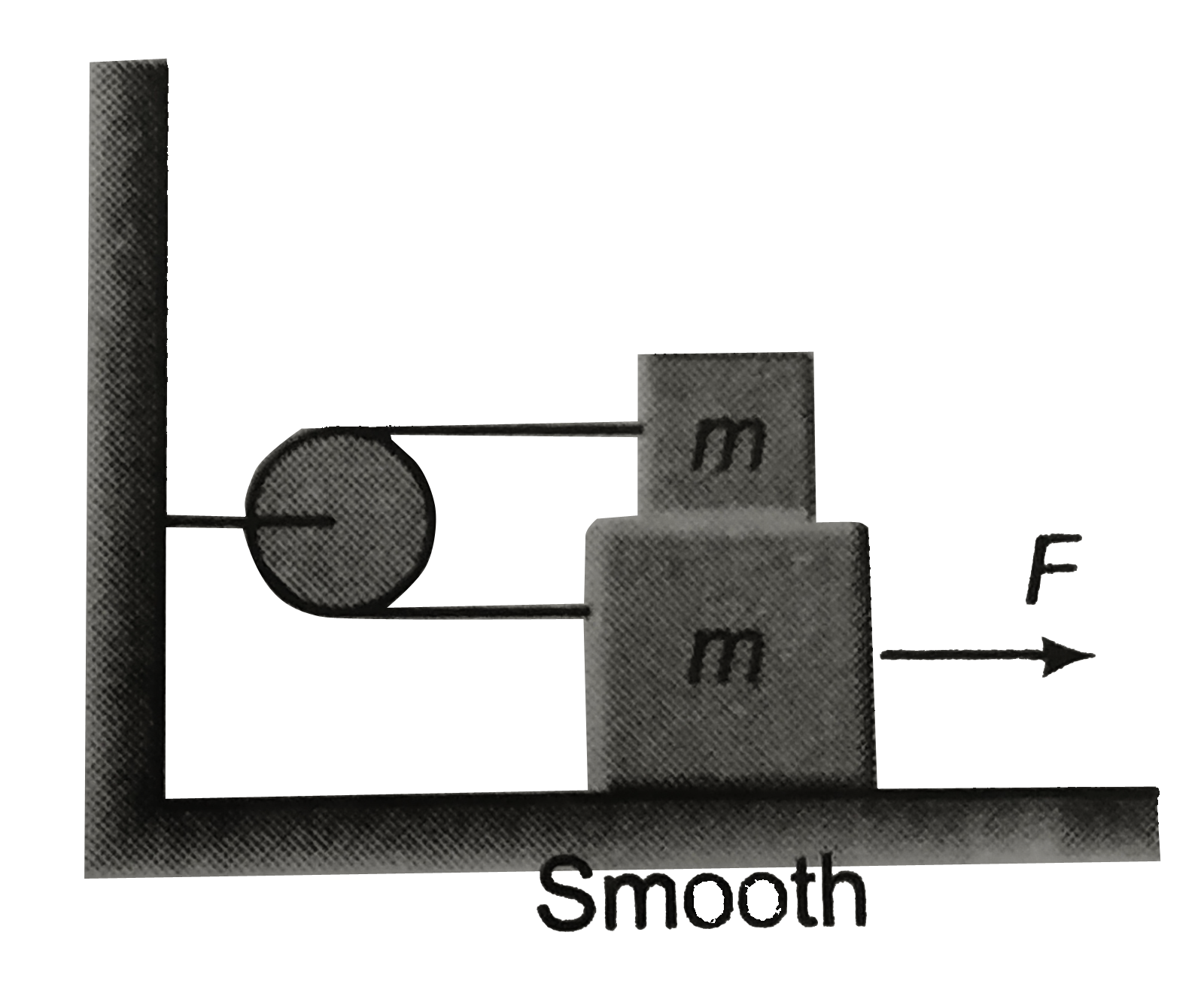Consider the situation shown in figure. The horizontal surface below the bigger block is smooth. The coefficient of friction between the blocks is . Find the minimum and the maximum force F that can be applied in order to keep the smaller block at rest with respect to the bigger block.

If no force is applied, the block A will slip on C towards right and the block B will move downward. Suppose the minimum force needed to prevent sliping is F. Taking A+B+C as the system, the obly exterN/Al horizontal force on the system is F. Hence the acceleratioinof the system is
..........i
Now take the block a as the system. The forces on A are.
 ,
,

i. tension t by the string towards right,
ii. friction fi by the block C towards left,
iii. weight mg downward and
normal force N upward
For veticla equilibrium N=mg
As the minimum force neede dto prevent slipping is appied, the fricton is limiting. Thus,
f=mu N=mu mgT-f=maT-mu mg=maN'=maf'=mu N'=mu maT+f'=mgT+mu ma =mga_(min)=(1-mu)/(1+mu) ga_(max)=(1+mu)/(1-mu)g(1-mu)/(1+mu)g and (1+mu)/(1-mu)g (1-mu)/(1+mu)(M+2m) g and (1+mu)/(1-mu)(M+2m)g.
Topper's Solved these Questions
- BOOK - HC VERMA ENGLISHCHAPTER - FRICTIONEXERCISE - Objective -110videos
FRICTION
- BOOK - HC VERMA ENGLISHCHAPTER - FRICTIONEXERCISE - Objective -25videos
FRICTION
- BOOK - HC VERMA ENGLISHCHAPTER - FRICTIONEXERCISE - Questions for short Answer11videos
FRICTION
- BOOK - HC VERMA ENGLISHCHAPTER - FLUID MECHANICSEXERCISE - All Questions90videos
FLUID MECHANICS
- BOOK - HC VERMA ENGLISHCHAPTER - GRAVITATIONEXERCISE - Question for short Answers18videos
GRAVITATION
Similar Questions
Consider the situation shown in Fig. The hirizontal surface below the bigger block is smooth the coefficient of friction between the block is μ find the minimum and the maximum force F that can be applied in order to keep the smaller blocks at rest with respoct to the bigger block
 View Solution
View SolutionIn the adjoining figure, the coefficient of friction between wedge (of mass M) and block (of mass m) is μ.
Find the minimum horizontal force F required to keep the block stationary with respect to wedge.
 View Solution
View Solution
Knowledge Check
- Question 1 - Select One
The coefficient of static friction between the two blocks shown in figure is μ and the table is smooth. What maximum horizontal forced F can be applied to he block of mass M so that the block move together?
 A0.15mgB0.05mgC0.1mgD0.45mg
A0.15mgB0.05mgC0.1mgD0.45mg
A block of mass m is placed on another block of mass M lying on a smooth horizontal surface as shown in the figure. The co-efficient of friction between the blocks is μ. Find the maximum horizontal force F (in Newton) that can be applied to the block M so that the blocks together with same acceleration? (M=3kg,m=2kg,μ=0.1,g=10m/s2)
 View Solution
View SolutionThe coefficient of static friction between the two blocks shown in figure is μ and the table is smooth. What maximum horizontal forced F can be applied to he block of mass M so that the block move together?
 View Solution
View SolutionFour block are arranged on a smooth horizontal surface as shown in figure .The masses of the blocks are given (see the fig ) The coefficient of static friction between the top and the bottom blocks is μs What is the maximum value of the horizontal force F applied to one of the bottom blocks as shown that makes all four block with the same acceleration ?
 View Solution
View SolutionA block of mass m is kept over another block of mass 2 m and the system rests on a smooth horizontal surface. The coefficient of friction between the blocks is 0.50. Find the work done by the force of friction on the smaller block by the bigger block during a displacement d of the system, when a force mg is applied to the lower block.
View SolutionTwo blocks A and B are lying on the table as shown in the figure. The coefficient of friciton between block A and block B is μ. The coefficient of friction between block B and ground also μ. An external force F is applied in the direction shown. The maximum value of the force F that can be applied without moving the blocks.
 View Solution
View SolutionFor the arrangement shown in the figure the coefficient of friction between the two blocks is μ. If both the blocks are identical and moving ,then the acceleration of each block is
 View Solution
View SolutionA small block of mass 'm' is placed on a plank of mass 'M'. The block is connected to plank with the help of a light string passing over a light smooth pulley as shown in figure. The co-efficient of static friction between the block and plank is μ.

The co-efficient of friction between the plank and the horizontal surface is zero. What maximum horizontal force F applied on the block of mass m can make the block and plank not to slide relatively?View Solution
